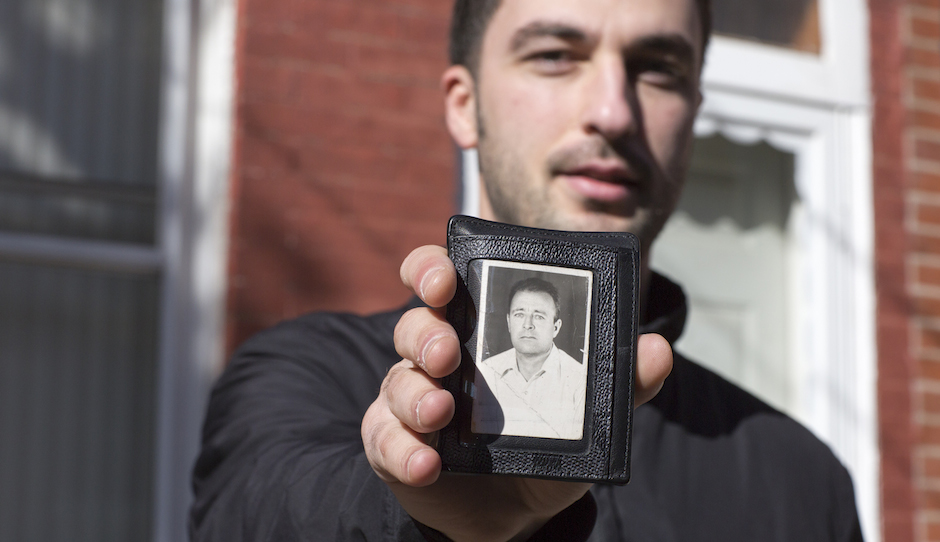Philly Block Project Wants to Show a Truer Portrait of Kensington

Hakan Ibisi carries a photograph of his grandfather in his wallet. Ibisi was photographed for the Philly Block Project, a collaboration between the Philadelphia Photo Arts Center and Hank Willis Thomas. Photo by Wyatt Gallery/Hank Willis Thomas Studio.
A smile creeps onto Fada Ahmad‘s face as she passes around a photo of the newest member of the family, her 1-year-old granddaughter. In the picture the young girl clutches onto her grandfather and a wide smile covers her face.
“She loves him more than anyone,” says Ahmad, laughing softly, as she talks about how the girl’s grandfather spoils her with gifts and candy. This is only one of the cherished photographs Ahmad has to share. Ahmad is the self-proclaimed photographer of her family. She has two suitcases full of photos at home. Today, she’s brought several snapshots and a cellphone packed with pictures.
“You are the keeper of your family archive,” remarks Lori Waselchuk, the coordinator of the Philly Block Project.
Ahmad’s archive is joining with another archive — actually quite a few other archives. Ahmad is at the Al Aqsa Islamic Society for a photo scanning event. Her photos along with the photos of many Kensington residents are being collected by the Philadelphia Photo Arts Center for something called the Philly Block Project. The aim of the project is to create a “visual narrative” of South Kensington that will be comprised of photos submitted by Kensington residents, in addition to photos of present day Kensington which will be taken by photographer Hank Willis Thomas and several other collaborating artists.
The preface of the project – which has been divided into a series of parts – will open March 10th at the center, located on the edge of South Kensington at 1400 N. American St. While the photos won’t be ready yet, the preface will include a panel discussion with the artists and a community meeting where residents and visitors can share their thoughts on the project. Earlier work by the artists will also be on display.
This summer, the completed project will be showcased, starting June 9th, with historical images submitted by residents; then on September 10th present-day images of Kensington will be displayed.
PPAC founder Sarah Stolfa said the project was started as a way to reach out to their neighbors.
“We realized we didn’t have any connection to our immediate neighbors,” said Stolfa, during a phone interview. “[We wanted] to do a project that really connected us with the community.” Stolfa described how one of the main goals is to create a dialogue, not only between the studio and the neighboring community but also between Kensington and the rest of Philadelphia. Stolfa explained how she believes outsiders are often shown a limited view of life in Kensington from the media. She hopes, through the project, to broaden the understanding of this unique part of the city.
“I think the people who come to Kensington to photograph come with an agenda; to photograph urban blight,” said Stolfa. “It’s not real — it’s not the whole picture, it’s not coming from the people.”
“People don’t realize that there are people that actually get along,” remarks Adab Ibrahim, the outreach coordinator of the Al Aqsa Islamic Society and also a longtime South Kensington resident, while at the photo scanning event. “It’s the bad news that gets the press.”
Additionally, Stolfa and project curator Kalia Brooks said the photographs will showcase the rich history of Kensington and how the neighborhood has changed up through present day. From there it will open up the question of where the neighborhood will go from here. Stolfa referenced the gentrification in the area and how it’s not uncommon to see a brand new building adjacent to an old residence. South Kensington is bordered by Fishtown and Northern Liberties, two neighbors that have experienced rapid growth. Now, Kensington residents say they’re seeing that development flow into their neighborhood, which is one reason Brooks and Ibrahim think it’s important to document the history now.
“We’re in a constant state of flux,” said Brooks. “The images you take with you really situate you despite the change around you.”
“You’re going to have new people moving in the condos and the history is going to go,” added Ibrahim, who’s lived in the neighborhood since 1987. She describes the project as “a little time capsule.”
Waselchuk said one of the challenges of the project has been getting residents to trust them with their photos. However, through the organization’s transparency and its hosting of photo scanning events, residents have started to open up to them. Emotions were definitely high at Al Aqsa Islamic Society, as Kensington residents shared both happy stories and somber stories from their past, like photographs of family members who have passed on.
Lead photographer Hank Willis Thomas said he just hopes “to make something the people are proud of,” and he will leave the rest of the interpretation open to the public.









Follow @MariamDembele on Twitter.


